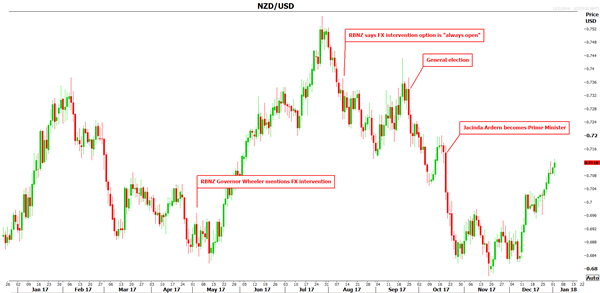The kiwi dollar retreated in 2017 amid falling dairy prices, political uncertainties, and a less-than-hawkish stance by the RBNZ. Are better times ahead for the NZD? That may depend primarily on whether and when the Reserve Bank will begin to raise interest rates. Market pricing is leaning towards a rate hike in 2018, but the RBNZ’s own forecasts suggest that will only happen in mid-2019. The market and the Bank are currently at odds, and something has to give.
The New Zealand dollar finished 2017 on the back foot, underperforming all its major peers besides the greenback. Dairy prices tumbled, the recent general election introduced considerable political uncertainty, and the Reserve Bank of New Zealand (RBNZ) refrained from providing any optimistic signals that rate hikes are looming. The Bank’s verbal warnings regarding the strength of the NZD and hints of direct FX intervention also played a role in the kiwi’s underperformance. Is a recovery, or further slump on the cards for 2018?
Kicking off with monetary policy, the RBNZ looks to be going nowhere fast. The Bank’s latest forecasts suggest interest rates may only begin to rise in mid-2019. Indeed, despite the rapid tightening in the nation’s labor market this year, wages hardly accelerated while core inflation remains subdued. Unless this changes drastically in 2018, it’s unlikely that the RBNZ will hurry to raise rates.
However, market pricing is not in line with this view. New Zealand’s overnight index swaps indicate a 72% probability for a quarter-point rate increase by the end of 2018. This has two major implications. First, if the Bank remains on hold as its own estimates suggest, that would come as a negative surprise to the market, thereby weighing on the NZD. Second, even if the Bank does act, so long as it only delivers one hike, any positive reaction in the kiwi could be relatively limited as most of this is priced in already. Most importantly, any major rallies in the NZD will likely see the RBNZ talking down the currency again, on concerns that a higher exchange rate could act as a drag on inflation and growth.

In terms of dairy products – New Zealand’s biggest export – not much is expected by futures contracts. Looking at whole milk powder futures on the New Zealand Derivatives Exchange (NZX), prices are expected to finish 2018 practically unchanged. Thus, absent some major surprise that alters this outlook, commodity prices seem unlikely to affect the kiwi much over the year.
Finally, the new Government is not something to overlook. The NZD plunged after the election, as uncertainty over the new administration’s policies set in. Some concerns were indeed justified, as the new regime soon cancelled tax cuts scheduled for 2018, and announced it will expand the RBNZ’s mandate to include full employment in addition to its price stability target. Importantly though, the administration’s agenda has since become much clearer in terms of what it will seek to implement, alleviating some uncertainty.
Taking everything together, downside risks seem to outweigh the upside ones for NZD, albeit not significantly. Kiwi/dollar could finish 2018 close to 0.6800, a level that acted as a reliable support barrier in 2017. On the other hand, if upside risks do materialize, for instance by the RBNZ raising interest rates or by milk prices rallying, the pair could surge and challenge the 0.7360 territory. However, a break above that hurdle could cause the Bank to intervene verbally by voicing concerns regarding the exchange rate, thereby keeping any further gains in check.
